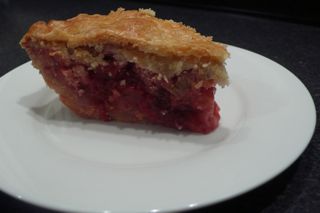 There is some magic in making a good pie crust. Even Nigella admits to being trepidatious about anything pastry. Indeed, I’m always at least a little anxious when making pie crust because there are so many details that could result in flabby, or glutinous, or hard, or flaky crust: the ratio of shortening to butter must be correct, the fats must be cold, the water must be icy, the dough mustn’t be massaged too thoroughly, the dough must be rested and chilled- but not too much, or it will crack when rolled out… No wonder nobody makes pies anymore when just the crust has so many potential pitfalls and one can buy a pie so much more easily.
There is some magic in making a good pie crust. Even Nigella admits to being trepidatious about anything pastry. Indeed, I’m always at least a little anxious when making pie crust because there are so many details that could result in flabby, or glutinous, or hard, or flaky crust: the ratio of shortening to butter must be correct, the fats must be cold, the water must be icy, the dough mustn’t be massaged too thoroughly, the dough must be rested and chilled- but not too much, or it will crack when rolled out… No wonder nobody makes pies anymore when just the crust has so many potential pitfalls and one can buy a pie so much more easily.
But there’s something to be said for homemade pie. One earns extra points when serving pie for dessert if it’s homemade, and even more points if even the filling is from scratch. If keeping score, Marc recently earned extra bonus points for a pie that not only had amazing crust and a scrumptious, sweet-tart filling, but which could be extracted from the pie plate cleanly and without any spill-over. Of course, there is no human alive that would turn down a slice if, during serving, it comes apart and spills over becoming somewhat unrecognizable as actual pie, but it portends a certain suave genius to serve a piece of pie that looks like it could be on display. His creation was of the strawberry-rhubarb variety, my second all-time favourite; apart from it’s perfect execution, I’m sure part of its deliciousness was owing to the absolutely perfect – truly perfect – strawberries contained within. Wow, those strawberries were blue-ribbon quality. What a difference buying local and vine ripened makes; they were deep red and just the purest essence of strawberry. The grocery store was selling them right next to a shiny basket of new rhubarb, thus making the mental leap from strawberry to rhubarb to pie that much more obvious. We happily walked right into that one.
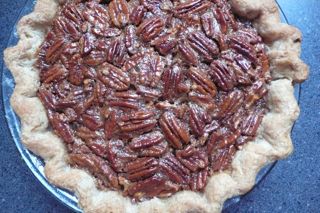
Before this, there was pecan pie, made only because of the surplus of pecans in the freezer. Those nuts only last so long and Trader Joe’s only sells them in enormous bags, so having bought the enormous bag, we were committed. Only 475 calories per slice.
The pecan pie was a revelation as it was the first pie crust we made with vodka. Yes, it turns out, that in addition to cocktails and sauce for penne, vodka can be used in pie dough. The recipe came from an episode of America’s Test Kitchen and explained the science behind the addition of vodka:
While gluten (the protein that makes crust tough) forms readily in water, it doesn’t form in ethanol, and vodka is 60 percent water and 40 percent ethanol. So adding 8 tablespoons of vodka produces a moist, easy-to-roll dough that stays tender (because it contains only 6 1/2 tablespoons of water). The alcohol vaporizes in the oven.
And now, forever more, I will add vodka to pie crust: partly as a practical step towards good pie, and partly as a superstitious sacrifice to the forces that grant a flaky crust.
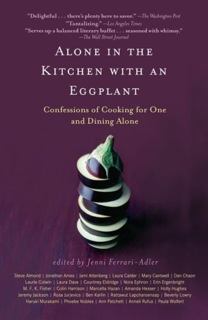 I’m currently reading
I’m currently reading 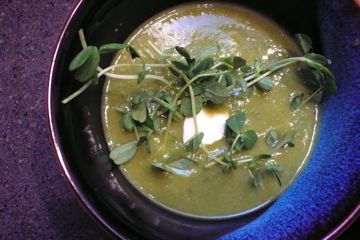 Made with frozen peas, this soup would be right up Nigella Lawson’s alley. We added some tarragon to this light, fresh version, and some crisp pea shoots which sat suspended on the surface above the white dollop of creme fraîche. Perfect with shards of warm, crunchy garlic bread.
Made with frozen peas, this soup would be right up Nigella Lawson’s alley. We added some tarragon to this light, fresh version, and some crisp pea shoots which sat suspended on the surface above the white dollop of creme fraîche. Perfect with shards of warm, crunchy garlic bread.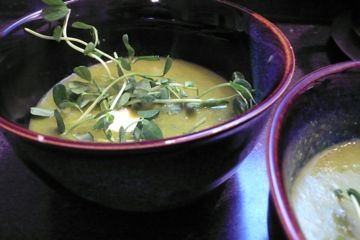
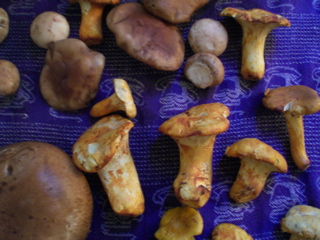 O, Mushooms! Nothing is more quintessentially fall than mushrooms. Wrinkly, dark, musty and aromatic, I will always favour a recipe in which they are involved. Divine in an omelette, earthy in a stew, dense in a salad; even a portebello can effectively masquerade as the patty in a burger. And my mushroom stems never go to waste as Sammy happily snarfs them up when offered.
O, Mushooms! Nothing is more quintessentially fall than mushrooms. Wrinkly, dark, musty and aromatic, I will always favour a recipe in which they are involved. Divine in an omelette, earthy in a stew, dense in a salad; even a portebello can effectively masquerade as the patty in a burger. And my mushroom stems never go to waste as Sammy happily snarfs them up when offered.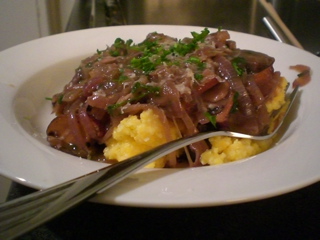 However, I fortuitously connected with another intriguing recipe in Nigella’s book: Mushroom Ragout. Now this, was going to be outstanding because truly, ragout is all that is fall. This recipe – my mouth waters just thinking about it – is all about wild mushrooms and this is how I chose to honour the chanterelles. Sautéed in butter and herbs, deglazed with white wine, thickened with a little flour, some onions and parsley and then sloppily served over soft, polenta with parmesan. The mushroom were just this side of firm and could not have been better presented or more flavourfully offered than in such a ragout. I should’ve garnished the bowls with newly fallen leaves.
However, I fortuitously connected with another intriguing recipe in Nigella’s book: Mushroom Ragout. Now this, was going to be outstanding because truly, ragout is all that is fall. This recipe – my mouth waters just thinking about it – is all about wild mushrooms and this is how I chose to honour the chanterelles. Sautéed in butter and herbs, deglazed with white wine, thickened with a little flour, some onions and parsley and then sloppily served over soft, polenta with parmesan. The mushroom were just this side of firm and could not have been better presented or more flavourfully offered than in such a ragout. I should’ve garnished the bowls with newly fallen leaves.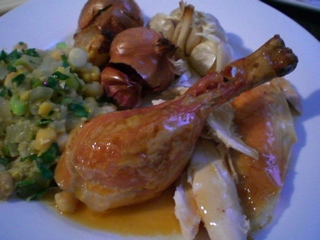 Years ago I read somewhere that of the smells that humans find most pleasing, roast chicken is number one. It beat the smell of bread baking, lavender, vanilla, freshly cut grass, strawberries, everything. I can’t deny that the smell of roasting chicken is divine, but I don’t know if I would necessarily agree that it is The Best; it has to do with context. When hungry, sure, the best smell in the world is probably roasting chicken, but when sleepy, the best smell might be the smell of lavender or of freshly washed sheets. On the same token, I don’t want to be smellin’ chicken when I’m in bed and I don’t want to smell laundry soap in the kitchen, but in the right context, each is equally as pleasurable. Vanilla, in its iced and creamy form, is lovely but doesn’t precisely evoke the pleasure of a summer day, where freshly cut grass would gain more points. Grass + ice cream = repulsive. But if you talk to someone who is allergic to grass, vanilla will rate higher in their book every time. Or what about someone from a non-western culture: cardamom might beat out vanilla; garlic might beat out bread. Smell, it must be acknowledged, is perhaps the most subjective sense of all and as such, how can anyone hope to rate one scent higher than another? Maybe instead of rating smells, it would be better to apply a verb or adjective. What does hungry smell like? What is the scent of learning? How does luxurious smell? (BTW, if you want to know what “cute” smells like, smell a puppy.)
Years ago I read somewhere that of the smells that humans find most pleasing, roast chicken is number one. It beat the smell of bread baking, lavender, vanilla, freshly cut grass, strawberries, everything. I can’t deny that the smell of roasting chicken is divine, but I don’t know if I would necessarily agree that it is The Best; it has to do with context. When hungry, sure, the best smell in the world is probably roasting chicken, but when sleepy, the best smell might be the smell of lavender or of freshly washed sheets. On the same token, I don’t want to be smellin’ chicken when I’m in bed and I don’t want to smell laundry soap in the kitchen, but in the right context, each is equally as pleasurable. Vanilla, in its iced and creamy form, is lovely but doesn’t precisely evoke the pleasure of a summer day, where freshly cut grass would gain more points. Grass + ice cream = repulsive. But if you talk to someone who is allergic to grass, vanilla will rate higher in their book every time. Or what about someone from a non-western culture: cardamom might beat out vanilla; garlic might beat out bread. Smell, it must be acknowledged, is perhaps the most subjective sense of all and as such, how can anyone hope to rate one scent higher than another? Maybe instead of rating smells, it would be better to apply a verb or adjective. What does hungry smell like? What is the scent of learning? How does luxurious smell? (BTW, if you want to know what “cute” smells like, smell a puppy.)